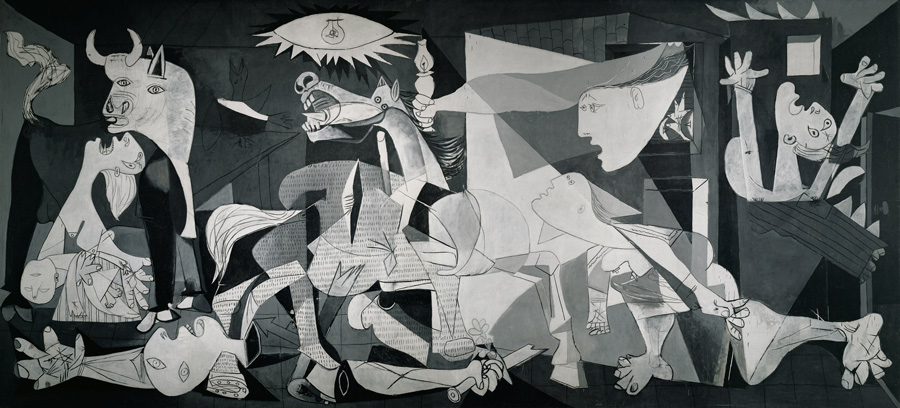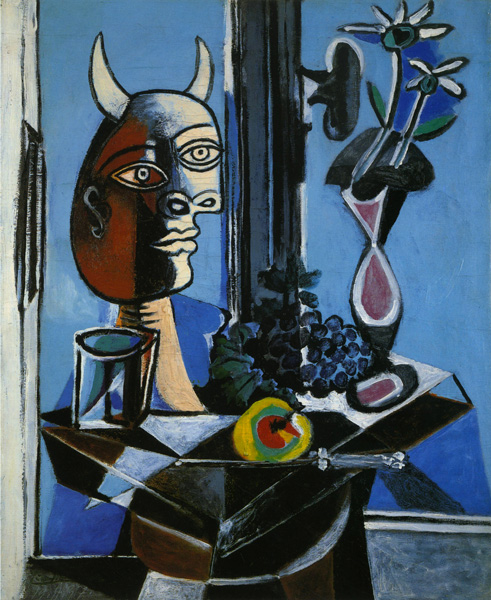Still Life of Palette and Bull's Head was painted in December 1938, in a period of unprecedented turmoil. In March, Nazi Germany annexed Austria; in September, Czechoslovakia was given up and occupied by the German army, and in early November the Jews of the Third Reich suffered the pogrom later referred to as Kristallnacht. In Southern Europe, the Spanish Civil War raged; General Franco's troops reached the border of Catalonia, while the volunteers from the International Brigades who had fought alongside the Republicans left the country. Although Picasso refused to make any comments, he remained more concerned than ever about the events in Spain, where his mother had just died. The artist had supported the Republicans ever since the beginning of the Spanish Civil War. In January 1937, he accepted the commission of a mural painting for the Spanish pavilion at the Paris World's Fair. The project, initially intended to address the theme of the artist and his model, was radically transformed after the bombing of the town of Guernica on April 26, 1937 by German planes. In just one month, Picasso completed his greatest masterpiece: a large-scale allegorical composition denouncing the horrors of war. In May 1937, Alfred Barr, the Director of the Museum of Modern Art in New York, reported that Picasso made the following statement: "In the panel on which I am working, which I shall call Guernica, and in all my recent works of art, I clearly express my abhorrence of the military caste which has sunk Spain in an ocean of pain and death." The piece that has since become an icon of human suffering above and beyond the war in Spain takes up the artist's recurrent themes: motherhood, the paired bull and horse, the woman holding a candle, and the warrior. Executed in shades of grey, the painting was put together from black-and-white photographs: initially, from images of the massacre that appeared in the newspapers, and then from the photographs of the work in progress taken by Dora Maar at Picasso's request, to help him examine and develop his composition. First and foremost, the monochrome treatment of the final outcome conveys the dehumanization in this scene of horror. According to a comment by Picasso's friend Roland Penrose, "he avoided the aesthetic distraction that color might have brought, and restricted the whole painting between the limits of white and black."
Upon approaching the still life Palette and Bull’s Head, the association with Guernica is inevitable. Produced the following year in black and white, it employs a similar economy of means. From an iconographic point of view, the imposing bull's head is clearly reminiscent of the one in the mural: mouth and nostrils in the same position, conveying a mute cry; the same placement of the eyes, both frontal and in profile. The pictorial matter is pared down, the shapes in the composition outlined with a single black line, while the paint used for the background has been completely thinned down with gasoline. We must not overlook the fact that it was difficult to obtain art supplies during that time, hence the use of gasoline as a solvent. However, Picasso's choice to use nothing but black is deliberate. The piece is actually the last in a series of five still lifes with a palette and the head of a bull or a Minotaur placed on a table, produced between November 4 and December 10, 1938. Given its composition, its style, and its monochrome treatment, Palette and Bull’s Head stands apart from the other works in the series, reminding us of the radicalism of Guernica. The first four canvases were painted in garish colors and a background reminiscent of the artist's late cubist period. They were probably all produced in the Tremblay sur Mauldre studio that Picasso set up at his dealer Ambroise Vollard's house. Vollard had actually lent him his home, about fifty kilometers southwest of Paris, so that Picasso could move his young mistress Marie-Thérèse there with their daughter Maya, born in 1935, keeping them away from prying eyes and from the disturbing events of the time. The artist, officially separated from his wife Olga since 1935, paid regular visits to this new family and was able to work at ease there. Beginning in 1936, he produced an important series of still lifes with a pitcher and fruit next to a window that eventually led to the transitional work Bust of a Minotaur in Front of a Window in April 1937 (Private collection, Z. VIII, 360) and announced the artist's metamorphosis into a Minotaur.






 Summary
Summary